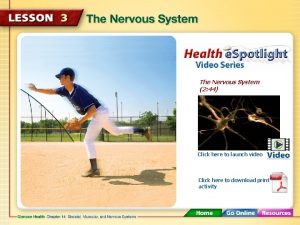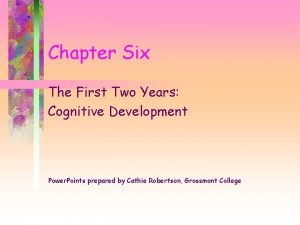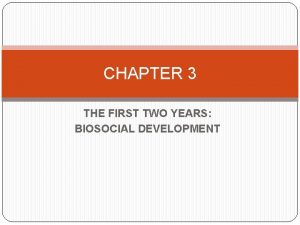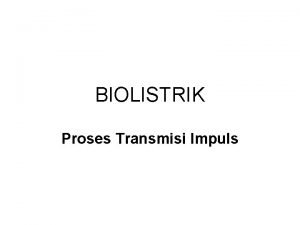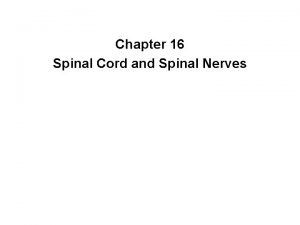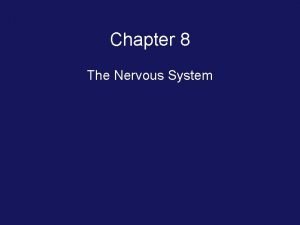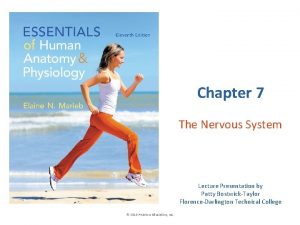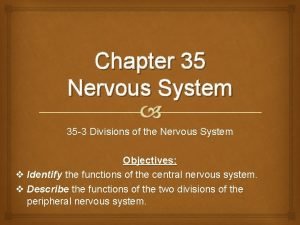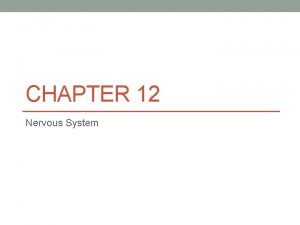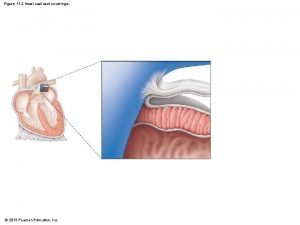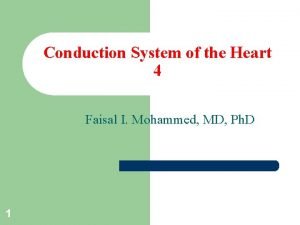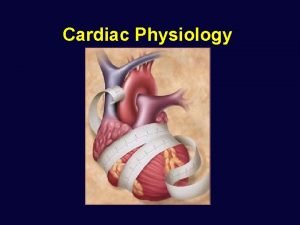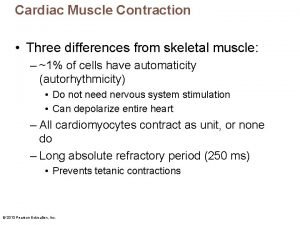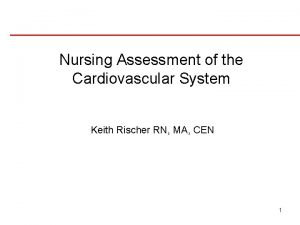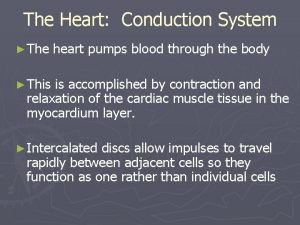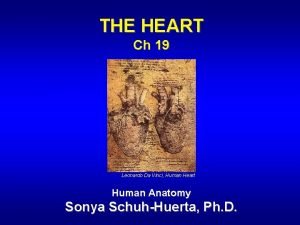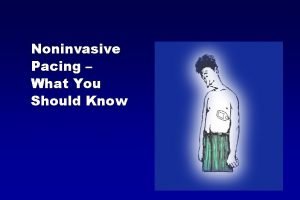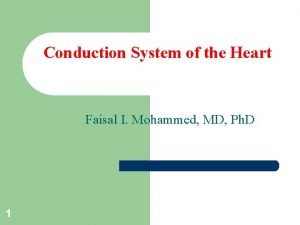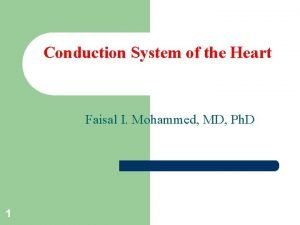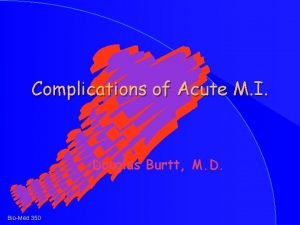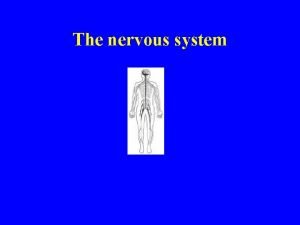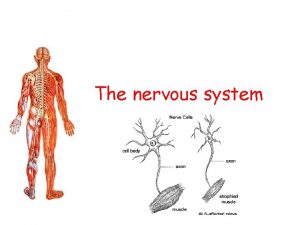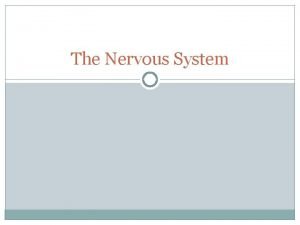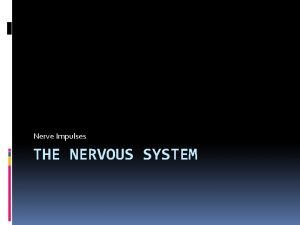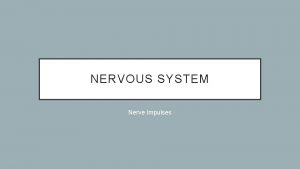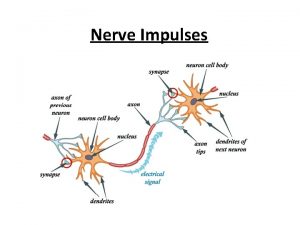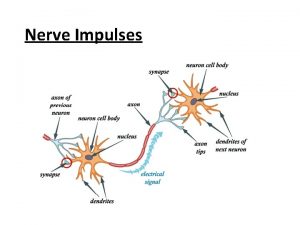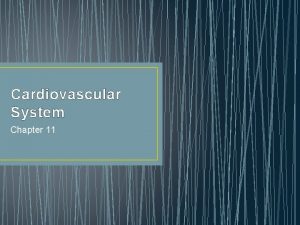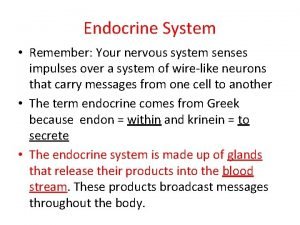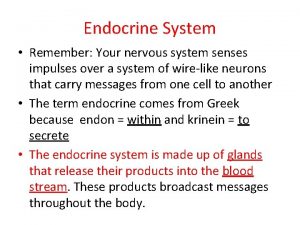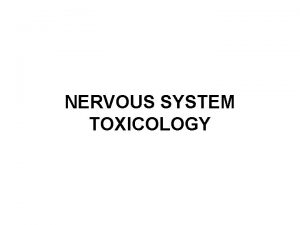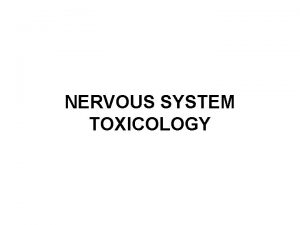The Nervous System Chapter 25 Conduction of Impulses










































- Slides: 42

The Nervous System Chapter 25

Conduction of Impulses • An impulse is a response to a stimulus that causes an action by the body. The impulse is like an electric signal that triggers the nervous system to react. • The nervous system receives information from internal and external stimuli and responds to that info. • While bacteria, protists, and plants are capable of nervous response, only animals have true nervous systems.

Nervous Response • There are 4 criteria that must be met for a nervous response to occur. – 1) there must be a way to detect a stimulus. In most cases, this is done by sensory receptors located all over the body. These receptors might be individual nerve cells or nerve cells that form part of a sense organ, like the eye or nose. These cells turn the sensory input into electrical impulses.

• 2) impulses must be transmitted to other parts of the body. They are carried along a network of neurons, which are cells designated for carrying nerve impulses. • 3) impulses have to be interpreted analyzed to determine the proper response. This is done in the brain or spinal cord.

• 4) an appropriate response must be carried out by an effector, usually a muscle or gland. This would be seen when you pull your hand away from a hot stove, or when you get a rush of adrenaline from your adrenal glands.

Nerve Tissue • There are 4 specific types of cells that form the tissues of the nervous system. – 1) sensory neurons transmit incoming impulses from receptors in sense organs (eyes, ears, skin, nose) to the brain or spinal cord, where they are interpreted. – 2) motor neurons act once the sensory neuron sends its message, which is analyzed in the brain. They transmit the outgoing response to the effectors.

• 3) interneurons carry impulses from sensory to motor neurons, forming a sort of bridge between them. • 4) nerves are many neurons grouped together, like an electrical cord made of many wires.

Anatomy of a Neuron • Part of a neuron looks like all other animal cells, and is called the soma (or body remember your prefixes? ). • Coming off one side of the soma is the axon. • It is long and narrow and has branches at the tail that form the end brush.

Neuron Structure

• The axon transmits impulses away (axon-away) from the soma and is covered in a material called the myelin sheath. • The myelin sheath helps to protect it from being exposed, and also helps impulses travel faster down the axon. • It also provides nourishment to the axon and helps in axon regeneration.

• From the other side of the soma come dendrites. • Dendrite means tree or branches, so you can imagine what these extensions look like. • The dendrites conduct impulses toward the cell body.

• The impulse is picked up by the dendrites, where it moves toward the soma, down the axon, out the end brush, and to the dendrites of another neuron until it reaches the control center (or an effector on the way back).

*Test Question Alert* • Identify the following parts of a neuron: – – – Axon Dendrite Soma Axon terminal Myelin sheath Nucleus

Transmitting Impulses from Neuron to Neuron • Virtually all nerve impulses must travel through many neurons before reaching their destinations: the brain, spinal cord, or effector. • However, the neurons don’t make a solid chain through the whole body. Instead, there are small fluid-filled spaces between the dendrites of one neuron and the axons of another. These spaces are called synapses.

Synapses

• The impulse travels across the synapses with the help of neurotransmitters. • These are chemicals found in vesicles located on the end brush of the axon. The vesicles fuse with the axon membrane, causing the chemical to be released, leaving the cell membranes and combining with receptor molecules found in nearby dendrites.

Neurotransmitters

Nervous Systems • Vertebrates, including humans, have 2 major nervous systems. The CNS consists of a brain and nerve cords. • These structures act as control centers, receiving messages from sensory neurons and sending responses via motor neurons. • The PNS consists of the sensory and motor neurons mentioned before.

CNS and PNS

• In humans, which are bilaterally symmetrical animals, the nerves come in pairs - one for each side of the body. • There are 12 pairs of cranial nerves attached to the brain and 31 pairs of spinal nerves.

*Test Question Alert* • Match the structure with the nervous system it belongs to (CNS, PNS). – Brain – Spinal nerves – Spinal cord – Cranial nerves

The CNS of Humans • Vertebrate brains are made up of 3 sections: the forebrain, midbrain, and hindbrain. • These 3 sections are further divided and named for their function.

Sections of the Brain

• In humans, the forebrain is made up of the cerebrum, which has two hemispheres. • Each hemisphere contains 4 lobes: frontal, temporal, parietal, and occipital.

*Test Question Alert* • Identify the lobes of the brain by the color they are on the diagram.

• The surface of the cerebrum is the cerebral cortex, made of neuron somas that are not covered in myelin sheath. They are referred to as gray matter. • The interior of the cerebrum is made of myelinated neurons and called white matter.

Gray and White Matter

• Also part of the forebrain, and located under the cerebrum, are thalamus and hypothalamus. • The thalamus sorts sensory information. • The hypothalamus controls hunger, body temperature, aggression, and metabolism. It also helps in endocrine (hormone) control.

The Forebrain

• The midbrain functions as a station for message exchange between fore- and hindbrain. • The hindbrain consists of the cerebellum, pons, and medulla oblongata.

The Midbrain and Hindbrain

• The cerebellum is the motor area of the brain, coordinating impulses sent from the cerebrum. • The medulla oblongata controls many responses of internal organs, like breathing rate, heart rate, and gland secretion. • The medulla oblongata and pons make up the brain stem

• The pons links the brain to the spinal cord and, along with the medulla, helps control respiration.

*Test Question Alert* • Match the function listed below with the section of the brain responsible for carrying it out. – – – – – Controlling respiration Gland secretion Coordinating impulses from the cerebrum Controls heart rate Controls hunger Controls aggression Sorts sensory information Controls body temperature Controls metabolism Controls breathing rate

*Test Question Alert* • Locate the following parts of the brain on the diagram: – – – Cerebrum Thalamus Hypothalamus Pons Medulla Cerebellum

*Test Question Alert* • Match the part of the brain with the section it belongs to (mid-, hind-, or forebrain). – – – Cerebrum Thalamus Hypothalamus Pons Medulla Cerebellum

• The spinal cord has a fluid-filled central canal. The cord itself is protected by bony vertebrae. • The exterior cord is white matter, while the interior surface is gray matter. • The spinal cord connects the brain with the PNS. It consists of the 62 spinal nerves, which contain both sensory and motor neurons.

The ANS of Humans • The ANS controls reflexes in the body that you don’t typically regulate, such as heartbeat and digestion. • It is made up of 2 groups of nerves that work like a checks-and-balances.

• The first group is the sympathetic nerves. • The sympathetic nerves speed up heart and breathing rate during emergencies or strenuous exercise, causing adrenaline and other hormones to be released, giving you a burst of energy.

• The parasympathetic nerves slow those processes down. It causes blood vessels to dilate (or expand), decreasing blood pressure. • Sympathetic nerves cause your pupils to dilate in low light, while your parasympathetic nerves relax your pupils, making them smaller in high light levels. • Sympathetic deals with stress/emergencies. Parasympathetic does the opposite.


*Test Question Alert* • Match the action with the system (sympathetic or parasympathetic) responsible for carrying it out. – – – – Dilation of blood vessels Dilation of pupils Speeding up heart rate Adrenaline release Relaxation of pupils Stress/emergency situations Increasing breathing rate
 Incoming sensory impulses and outgoing motor impulses
Incoming sensory impulses and outgoing motor impulses Which neuron is rare
Which neuron is rare Sensory input and motor output
Sensory input and motor output What are neuron processes
What are neuron processes Social impulses foster infant language
Social impulses foster infant language Social impulses foster infant language
Social impulses foster infant language Biolistrik
Biolistrik Transmits nerve impulses
Transmits nerve impulses Integration center
Integration center Nervous system and digestive system
Nervous system and digestive system Endocrine system vs nervous system
Endocrine system vs nervous system Nervous system vs endocrine system venn diagram
Nervous system vs endocrine system venn diagram Endocrine system
Endocrine system Componentes componentes
Componentes componentes Chapter 15 nervous system diseases and disorders
Chapter 15 nervous system diseases and disorders Chapter 8 the nervous system
Chapter 8 the nervous system Chapter 7 the nervous system figure 7-2
Chapter 7 the nervous system figure 7-2 Chapter 35 nervous system
Chapter 35 nervous system Chapter 14 the skeletal muscular and nervous systems
Chapter 14 the skeletal muscular and nervous systems Chapter 12 nervous system
Chapter 12 nervous system Figure 11-6
Figure 11-6 Conduction system of heart
Conduction system of heart Intrinsic conduction system
Intrinsic conduction system Pacemaker potential
Pacemaker potential Cardiac landmarks
Cardiac landmarks 300 150 100 ekg
300 150 100 ekg The conduction system
The conduction system The conduction system
The conduction system Undersensing ecg
Undersensing ecg Equiphasic approach ecg
Equiphasic approach ecg Conduction system of heart
Conduction system of heart Conduction system of the heart
Conduction system of the heart The conduction system
The conduction system Arriythmia
Arriythmia Chemical messengers of the nervous system
Chemical messengers of the nervous system Nematoda segmentation
Nematoda segmentation The nervous system is made up of
The nervous system is made up of Three basic functions of the nervous system
Three basic functions of the nervous system Learning objectives of nervous system
Learning objectives of nervous system What is stimuli in nervous system
What is stimuli in nervous system Spinal cord structure
Spinal cord structure Autonomic nervous system visceral
Autonomic nervous system visceral Nervous system def
Nervous system def
